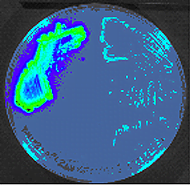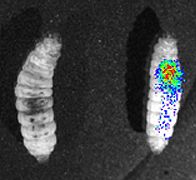READING, England, Sept. 9, 2009 – By attaching light-emitting genes to infectious bacteria in an experimental system, researchers at University College, Cork, Ireland, have been able to track where in the body the bacteria go – giving insight into the path of the infection process, which could lead to the development of more targeted treatments.

The food-borne pathogen Listeria monocytogenes can be made to emit visible light (bioluminescence). This allows tracking of the bacterium using sophisticated camera technology. Image courtesy of Dr. Peter Bron and Dr. Ian Monk.
At the Society for General Microbiology’s meeting at Heriot-Watt University, Edinburgh, Dr. Cormac Gahan described how his research team had manipulated the infectious food-borne pathogen Listeria monocytogenes to emit enough light for an ultrasensitive camera system to detect these bacteria during infection of living mice in real time. This noninvasive procedure allowed individual animals to be analyzed over the course of a lengthy infection and therefore reduced the numbers of animals required for infection studies.

Bioluminescent Listeria can be used to infect moth larvae as a model for studying the disease process. The larva on the right is infected with bioluminescent Listeria, and the levels of light correspond to the numbers of bacteria and allow localization of the signal. Image courtesy of Dr. Susan Joyce.
This bioluminescence technology showed the researchers that Listeria bacteria migrated to the kidneys and gallbladders of normal mice during infection. In mice with cancer, the bacterium migrated very efficiently to the tumor tissue. The team went on to investigate the possibility that Listeria could be used to kill tumor cells by delivering DNA containing the codes for proteins to kill the tumor.
“Bioluminescence imaging in bacterial infections has great potential to provide information on the cause of infectious diseases,” said Gahan, “The technology allows the researcher to pinpoint exactly where in the body the bacteria reside during infection. We have also demonstrated that the technology can indicate which bacterial genes are switched on during infection. The use of this approach will underpin the development and testing of new vaccine and DNA-delivery vectors for protection against bacterial diseases.”
For more information, visit: www.ucc.ie